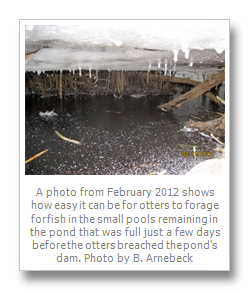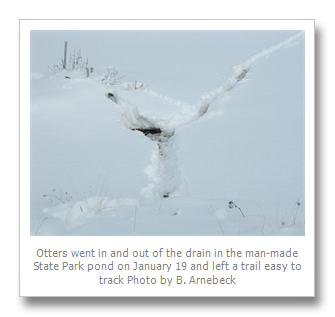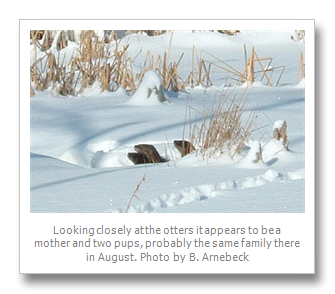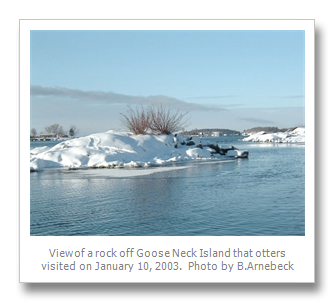Written by
Bob Arnebeck posted on November 13, 2012 07:35
The best thing about Thousand Island Park is its proximity to the swamps of Wellesley Island.
When I insulated our summer place for year-round living, I discovered that the most exciting animals in those swamps were the otters which came up from the St. Lawrence. Mother otters liked to raise their pups in beaver ponds, feeding them the bullheads that are so easy for otters to catch as they sleep in the mud all day. It was easy to tell that the otters came up from the river. On a snowy December morning in 1997, with my wife and 10 year son, I followed the tracks of two otters off the bay and into a pond. Going over the first ridge we stumbled upon two adult otters first playing in the snow, and then swimming in the half frozen ponds looking for fish to eat.

December is a relatively easy month for the mammals in the Thousand Islands, but by mid-January conditions usually get harsh. In North America all otters are born around April 1 and in the Thousand Island regions pups have about 10 months to learn how to fend for themselves. Around February the otter mothers’ singled minded devotion to their pups ends as they prepare for mating. However to make that first winter easier for the pups, a mother returns with them to the beaver ponds where she raised them in the summer. During my first winter on the island, I observed otter families in the ponds and it struck me that just as the mother teaches her pups to swim in the confines of a small pond, it made sense for her to teach her pups how to manage ice and snow in the confines of a small frozen pond.
The otter families I watched usually left the ponds for the river by November. I started looking for them to return in late December for the pups’ winter semester, so to speak. All I saw were a lot of hard working beavers making their preparations for winter.
The winter of 2003 hit hard. Foggy warmth kissed us goodbye on New Year’s Day. We soon got a sheet of ice on the bays and we could skate over the bullheads, pike and perch safe at last from
the foraging of otters. Then ice locked all the shores. The river was ready to freeze but the wind and snow kept it open. Brisk winds roiled the river on the heels of two snowstorms. I reasoned that otters in the river would notice all that and move promptly into the quiet of the ponds where beavers had made holes in the ice near their lodges and dams. I hiked and then skied around the ponds and saw no signs of otters.
My dock faces the sun which ironically never seems quite so warm as it does on the clear mornings when the temperature hits 10F. With the weather momentarily calm , I freed my 14 foot aluminum boat. (I always keep a boat in the river.)
I had taken the engine off so once I got the boat floating and pushed it over the remaining ice and into the river, I had to row. My dock faces Goose Neck Island which is across the American channel from Rock Island light. When I got to the channel side of the island I saw otter slides through the deep snow on the granite sloping down to the water. There is nothing on a rock that otters eat but they evidently can’t resist a good slide. After a short romp on the island they had plowed over two small rocks out in the river. I rowed home and clapped on the skis. I had a clear picture of the otters bidding adieu to their river haunts and heading for the beaver ponds before ice covered the river.

Out in the ponds the snow and cold slowed the beavers down but there were still no signs of otters. By the 14th there was only a patch of open water in front of my dock. I could have floated down river towards Alexandria Bay but the rest of the river was frozen over, but still no otters in the beaver ponds. Then after a night of snow, the 19th dawned a perfect sunny cold day. My wife and I skied across South Bay and then up onto the man-made pond on the west end of the island. Finally etched in the smooth white expanse of the pond were the slides of three otters. Judging from their size, a mother and her two pups cross the pond and headed east up a series of small ponds.
An Otter mother feeds her pups. By B. Arnebeck
|
There is nothing quite like skiing on a trail that otters broke. As they ran and slid their eyes could not see over the foot deep snow, but their bellies know more about the earth than our brains. The cliché about otters is that they are playful, but these otters were not on a lark. In each small pond they crossed they looked for holes. There was nothing to eat in the snow. They had to get under the ice. Judging from the otter scats outside a hole by a drain pipe in the big man-made pond, they had already had a meal. At the next big pond they found some holes into a beaver burrow but perhaps found no vacancy. Or maybe they were just heading home. Back in the summer I had watched a mother and two pups swim in a large beaver pond near one of the State park’s nature trails.

The slides in the snow eased down onto that pond, all ice and snow now that four months ago was a paradise of ferns, cattails, commodious beaver lodges and shallow water pulsing with bullheads, shiners and frogs. We paused on our skis and I was reminding my wife of where a creek entered the pond and where the ice might be weak, then the heads of three otters popped up over the snow. We froze, but they disappeared, and we didn‘t see them again even though through the middle of April we often saw their slides and scats on that pond and all the neighboring beaver ponds. In the winter the otters forage under the ice. Their slides in the snow only mark their moving from one likely fishing hole to the next. Sometimes a week passes before they come back out of those holes and move on.

How do they live under the ice? Simple, dig a hole through the beavers’ dam, let the water drain out and race around under the ice until it collapses feasting on fish left behind when the water left. Toward the end of winter I can eventually get my head under the ice and squint into a sunless alien world as far as far as I can imagine from the depths to the river where otters flourish most of the year. If I ever half figure out that under ice world, I’ll tell you about it.
Two Otters playing in the snow by B. Arnebeck
|
|
By Bob Arnebeck, Wellesley Island
Bob Arnebeck is a writer who lives year-round at Thousand Island Park. He moved to the islands with his family in 1994 from Washington, DC, where he was a free lance journalist and historian. In 1991 his “Through a Fiery Trail: Building Washington 1790-1800, published by Madison Books and Proust's Last Beer: A History of Curious Demises. Links to his web pages and blogs about his experiences with animals in the Thousand Islands can be found at http://bobarnebeck.com.